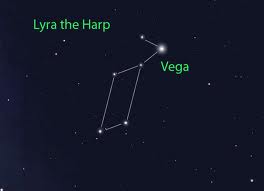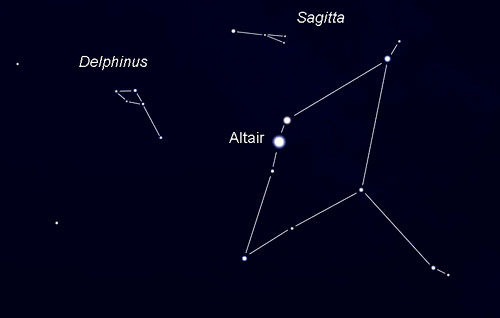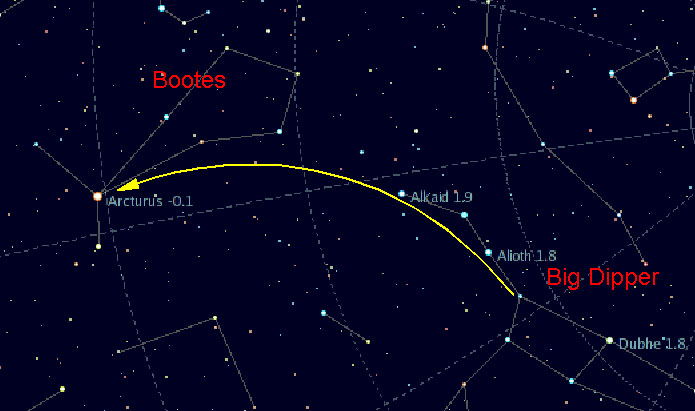Summer Constellations
Use this page from your smart phone to help you find and identify summer constellations. The page background is black and the text is red to help preserve your night vision.
The instructions below will guide you step by step through the main constellations and stars in the summer sky for the Northern hemisphere. It is assumed the observer is somewhere between 30 and 40 degrees longitude and the local time is about 10pm.
Notes:
- Star names are in [square brackets]
- Constellations names are underlined
- Alternate names are in (parenthesis)
The night sky has been studied by people for probably all of history. The ancients had no idea what stars were. Most thought that they were magic of some sort and that stars were comparatively small and close. The word "Planet" means "wanderer". The ancients knew that some stars moved through the constellations through the years. Some people thought these special wandering stars were gods moving through the heavens.
The names of the constellations below come to us largely from Greek culture that is over 2500 years old, but every culture has their own names and ideas about them. Looking at the stars was very practical in that it helped ancient people tell time and direction. Today, we know what the constellations are because of the invention of the telescope and other scientific tools. However, we still use the stars as a way to guide us in our travels, and even as reliable clocks.
Summer Triangle
We'll start by finding the three brightest stars in the sky. This triangle will be your reference point for locating constellations.
[Vega] is almost straight overhead, slightly to the East. Next to vega is the constellation Lyra (The Harp). Vega is pretty close to us, just 25 light years away. [Beta Lyrae], in the lower right corner of Lyra, is 1000 LY away (40 times further), which shows that just because stars appear close to each other, it does not mean they are close in 3D space. [Vega] was the pole star about 12,000 B.C., but the procession of the earth gradually changed that to [Polaris]. [Vega] will be the pole star again in about 11,000 years.

[Deneb] is Northeast of Vega and part of the constellation Cygnus (The Swan). [Deneb] is a blue super giant – a very big, bright and powerful star. It is 2600 light years away, but is still one of the brightest stars in the sky. [Deneb] will be an approximate pole star in around 7000 years.

[Altair] is Sourtheast of Vega and part of the constellation Aquila (The Eagle). It is the closest of the Summer Triangle stars at about 17 light years.


Directly overhead is the constelation Hercules. You find it by trancing a line from [Deneb] through [Vega].

The Big Dipper
The big dipper is probably the most recognizable pattern of stars in the sky. Starting from there, we can find several other stars and constellations. We call it the "big dipper" in the United States, but the ancients knew it as a plough or as part of Ursa Major (The big bear). All of the stars in the big dipper are fairly close as stars go, between 50 and 125 light years. In total, there are probably ~1000 stars within 125 light years of us.
Following the arc of the dipper's handle, we can "arc to [arcturus]", one of the brightest stars in the sky. [Arcturus] is also the brightest star of the constellation Bootes (The ploughman. pronounced Boo - ootees). With a little imagination, you can see the ploughman operating his plough, which is the big dipper.
In the direction of Bootes, astronomers have discovered a huge void- a region of the universe that has very few galaxies. The universe has a structure like a collection of bubbles, with galaxies where the bubbles meet and voids inside the bubbles. The universe has countless voids, but the void in the direction of Bootes is one of the largest known and studying it helps physicists to understand the conditions of the early universe.

Going the other way, you can follow the pointer stars in the cup of the big dipper to [Polaris] (the North Star). [Polaris] is part of the constellation we call the little dipper, also known as ursa minor (the little bear).

If you keep tracing the line past [polaris], you will get to the constellation Casseopeia (The Queen). It looks like a great big 'W'.

The most distant object visible to the naked eye can be found near the constellation Cassiopeia. The right-hand part of the "W" points generally in the direction of the Pegasus constellation. Just before that constellation is a smudge in the sky. That smudge is an entire galaxy of stars even bigger than the Milky Way. It is 2.5 MILLION light years away!
Even though we can see it with our eyes, we did not know what galaxies were until about 100 years ago. A scientist named Edwin Hubble studied special stars that blink very slowly. Some of those stars are near enough that we can measure their distance directly and scientists learned that We can know how bright the blinking stars are because the speed at which they blink is related to their brightness. It turns out that with a little math you can tell how far away something is if you know exactly how bright it is. Hubble used this fact to prove the Andromeda "smudge" was actually far, far outside of our own galaxy and must itself be a galaxy of billions of stars. Hubble went on to show that all the far away galaxies appear to be flying away from us in every direction. This was the observation that showed the universe had a beginning and was not static as most people (even Einstein) thought. The Hubble Space Telescope was named after him for these great discoveries.
--------------------------------------
Constellations and stars I plan to add later: [Antares] Scorpius (The Scorpion)
"Spike to Spica"
[Spica] Virgo (The maiden)
East of Scorpius - Teapot, Sagittarius (The archer) just above the spout is the center of the milky way